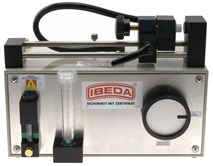Monday, August 5, 2013
NEW BLOG - Flashback Arrestor Testing Machine
Did you know that all flashback arrestors in service are
required to be tested at a minimum interval of 12
months*? This is to ensure that they are still
working within the manufacturer's design parameters required to
give you maximum safety.

The Ibeda flashback arrestor testing machine is purposely built
to test flashback arrestors for through flow, reverse flow and
additionally, to test the cut-off feature on resettable flashback
arrestor models.
The design of this machine allows quick testing of all flashback
arrestors, regardless of the thread sizes. You only need to supply
(oil free) inert gas and have water available to fill the reverse
flow tube and you are set to go. No electricity is needed.
Not all flashback arrestor products can be tested on
this testing machine!
While some flashback arrestors state that they meet AS4603, this
is not always the case, so it is important that you do your
homework. One key point is to determine whether the products
have been tested by an independent qualified third party and a copy
of the certificate is available from the supplier. Product
labelling, instruction sheets, flow rates and values must also be
checked and approved before these items can be listed for testing
on the Ibeda Testing Machine. Currently, no products made in the
UK, Taiwan or China have been approved for testing on the Ibeda
manufactured testing machine.
TeSuCo (the Ibeda agent in Australia since 1988) and Ibeda in
Germany have worked together to provide the latest in design and up
to date information. The Ibeda website is a great resource for
instructional videos and product information. Visit them at: www.ibeda.de
The Ibeda flashback arrestor range is still the only range
currently on the Australian market which has been product certified
to AS4603. This certification has been conducted by BAM, The
Federal Institute for Materials Research and Testing, located in
Berlin, Germany.
* Australian Standard AS4603 (Section 3.3) and AS4839
(Guidance Table 1)
Wayne Morris
Comments
Add Comment